
Crème légère is a light yet flavourful French cream that can be used inside tarts, as a filling for choux pastries or to fill your favourite cakes, desserts and pastries. Made by combining pastry cream with whipped cream, it has the delicious flavour of vanilla custard but with a more light, airy texture.

[feast_advanced_jump_to]
What is Crème Légère
Crème légère (“light cream” in French) is a mix between Crème Pâtissière (Pastry Cream) and Crème Diplomate (Diplomat Cream). It is simply made by folding whipped cream into pastry cream.
It is less stable than diplomat cream because it does not use gelatine to set, but is much lighter and fluffier than pastry cream thanks to the high ratio of whipped cream. Just like Pastry cream, it is usually made with vanilla but can be flavoured with many other ingredients such as chocolate, coffee or fruit.
In classic French pastry, Crème Légère it is also sometimes called “Crème Princesse” or “Crème Madame” (Princess Cream / Madam Cream).
Ingredients
What is Crème Légère made of:

Scroll down to recipe card below for all quantities
Ingredients notes:
- Milk: use a full cream / whole milk that contains 3 to 4% fat for the best flavour and texture. I don’t recommend using a skim or fat-reduced milk. I have made this recipe with soy milk for a dairy-free alternative and it does work.
- Vanilla: you will always get the best vanilla flavour from a fresh vanilla bean, but it can be quite expensive. The best second option would be a high quality vanilla paste. The recipe will work with vanilla extract but your cream won’t be as flavourful.
- Egg Yolks: from large eggs, at room temperature.
- Cornstarch: can be substituted with plain / AP flour but I personally like cornstarch for a lighter consistency.
- Cream: thickened / heavy cream with at least 30 to 35% fat content. A cream with a lower fat content will not whip properly and deflate quickly.
Optional: Butter. Soft butter, added to the pastry cream after cooking it, will give it extra richness and help it set a bit firmer once chilled. I don’t personally find it necessary here.
Flavour Variations
- Make a chocolate version by using my Chocolate Pastry Cream instead of vanilla pastry cream.
- Substitute some (or all) of the milk with a fruit juice or puree.
- Infuse the milk with coffee or tea.
- Make a pistachio version by using my Pistachio Pastry Cream as a base.
How to make Crème Légère
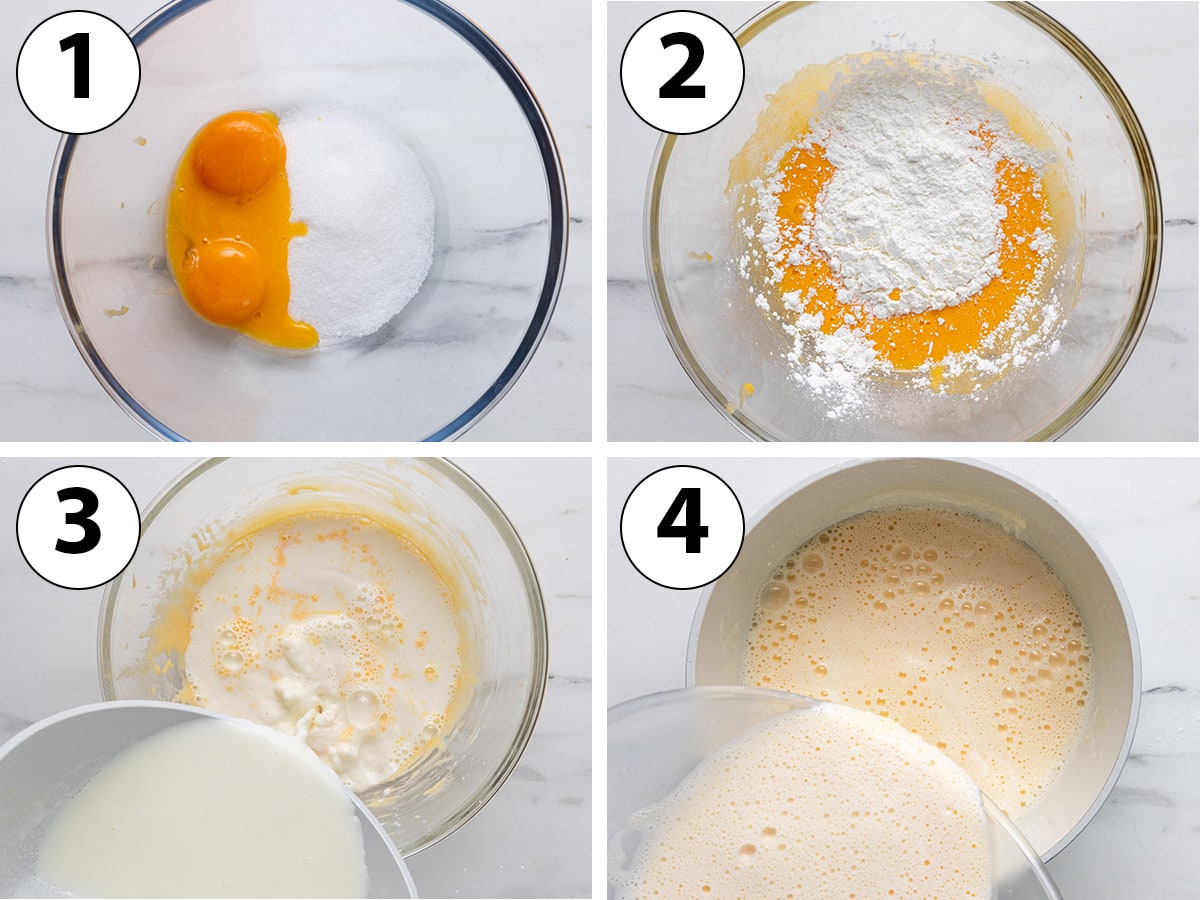
- Place the Milk in a medium-size saucepan. If using a vanilla bean, slice it in half lengthwise, scrape the beans inside the vanilla pod and add them to the milk along with the remaining pod. Turn on medium low heat and bring to a simmer. Once it starts to simmer, turn off the heat, cover with a lid and leave to infuse for at least 20 minutes.
If using vanilla paste or extract, you do not need to infuse the milk first.
- Photo 1: in the meantime, whisk the egg yolks and sugar in a large heatproof bowl until smooth.
- Photo 2: add the cornstarch and mix until no lumps remain. The mixture should be quite thick.
- If you have been infusing the milk with vanilla, remove the pod and bring back to a simmer.
- Photo 3: slowly pour the warm milk over the egg mixture while you continuously stir to “temper” the eggs. Whisk well until fully combined.
“Tempering” is a way to slowly bring up the temperature of the egg yolks. This allows to avoid a temperature shock that could make the eggs scramble.
- Photo 4: Pour the whole mixture back into the saucepan over low heat.

- Photo 5: making sure to remain over low heat, cook for about 5 minutes or until the custard has thickened. Continuously whisk while the cream is cooking so that it does not stick to the bottom of the pan. Make sure it does not boil or you risk overcooking the egg yolks.
If you are making a larger batch, you can work on a slightly higher temperature but make sure not to go over medium heat.
- Photo 6: For the perfect result, use a kitchen thermometer and cook the pastry cream to 82 to 84 degrees Celsius (180 to 183 degrees Fahrenheit). Over that temperature, the eggs will start to curdle.
- Transfer your pastry cream into a large clean bowl or shallow pan (to cool it down more quickly). Cover with plastic wrap and press it down so that it touches the surface of the cream. Place in the fridge to chill and set for at least 2 to 3 hours, preferably overnight.
- Photo 7: Pour the cold heavy cream in a large bowl (if using a hand mixer) or the bowl of your stand mixer fitted with the whisk attachment. Start whipping the cream on medium speed, slowly increasing to medium-high spread until you reach stiff peaks.
I recommend slowly down after reaching medium peaks so you can insure you keep whipping the cream without going over stiff peaks, where the cream would start turning grainy.
- Take the chilled pastry cream out of the fridge and transfer into a large bowl (if it was chilling in a shallow pan). Using a whisk, beat it lightly to loosen it.
- Photo 8: Add about 1/4 of the whipped cream to the pastry cream and gently whisk until fully incorporated. Switch to a spatula and add the remaining whipped cream in two or three times, gently folding it into the custard.
Make sure to be gentle when you fold in the cream with a spatula to avoid deflating it by popping the air bubbles created when whipping it.
- If not using straight away, keep stored in the fridge until ready to use.
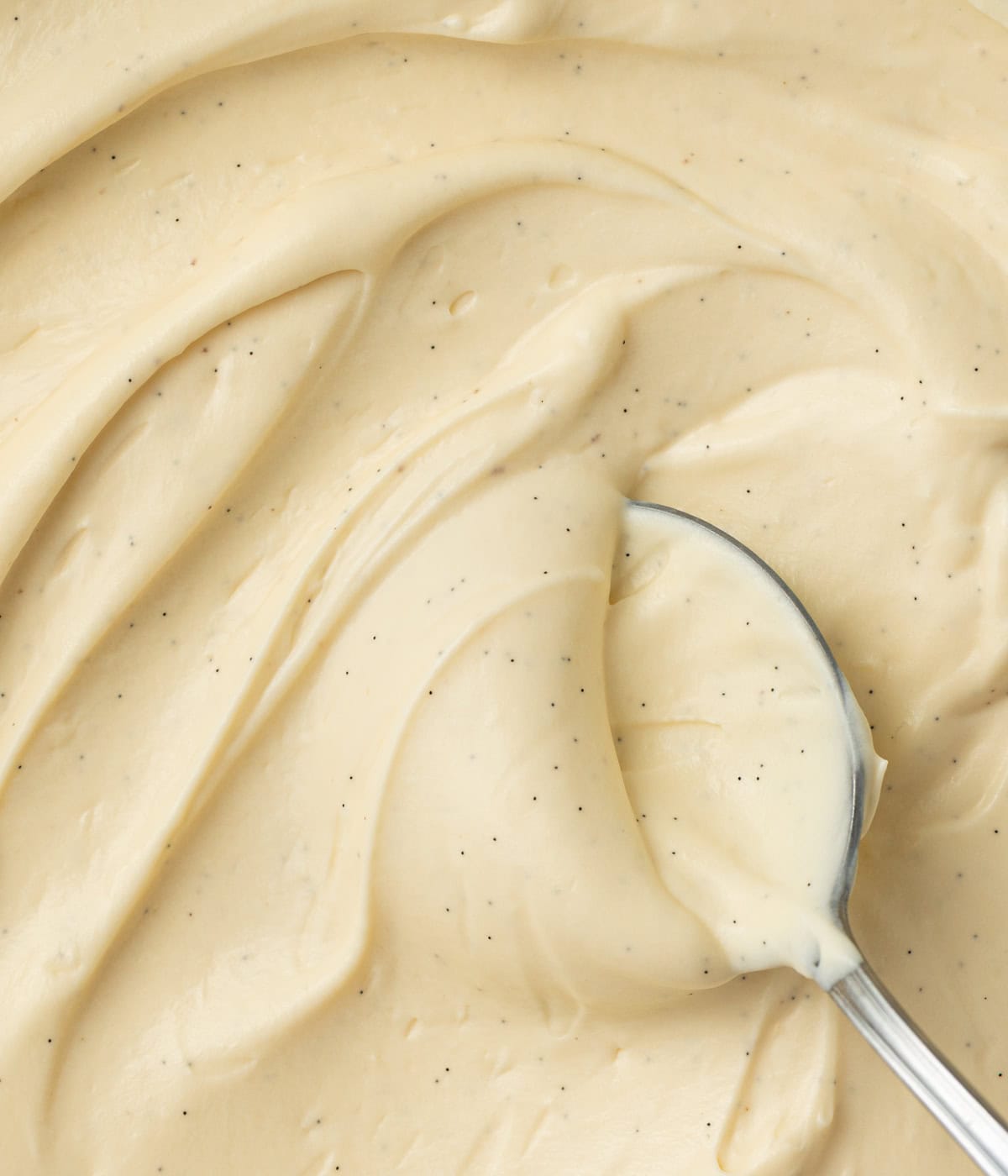
Recipe FAQs
The only difference between crème légère and diplomat cream is the use of gelatine to stabilise the cream for a diplomat cream. Creme Diplomat is thicker and will hold its shape well while creme legere is lighter in texture and less stable.
In terms of flavours and texture, crème légère is probably the closest to Bavarian Cream. They are both made with a custard base and whipped cream.
There are two differences:
– bavarian cream is made with a crème anglaise base instead of crème pâtissière. Crème anglaise is a type of custard thickened only with eggs, without any added flour or starch.
– bavarian cream uses gelatine as a thickener and stabiliser.
Lightened Pastry Cream makes a great filling for cakes, entremets, tarts and pastries. But because it is less stable than the version made with gelatine, it won’t be able to support a lot of weight.
I would not use it as frosting because of its lighter, softer texture.
For this recipe, I used a 2:1 ratio of milk to cream. It gives you a well balanced cream that is still rich in flavour but has a nice light flavour. You can increase or decrease this ratio based on the texture you are after – and how light of a flavour you want. I don’t recommend going over a 1:1 ratio.
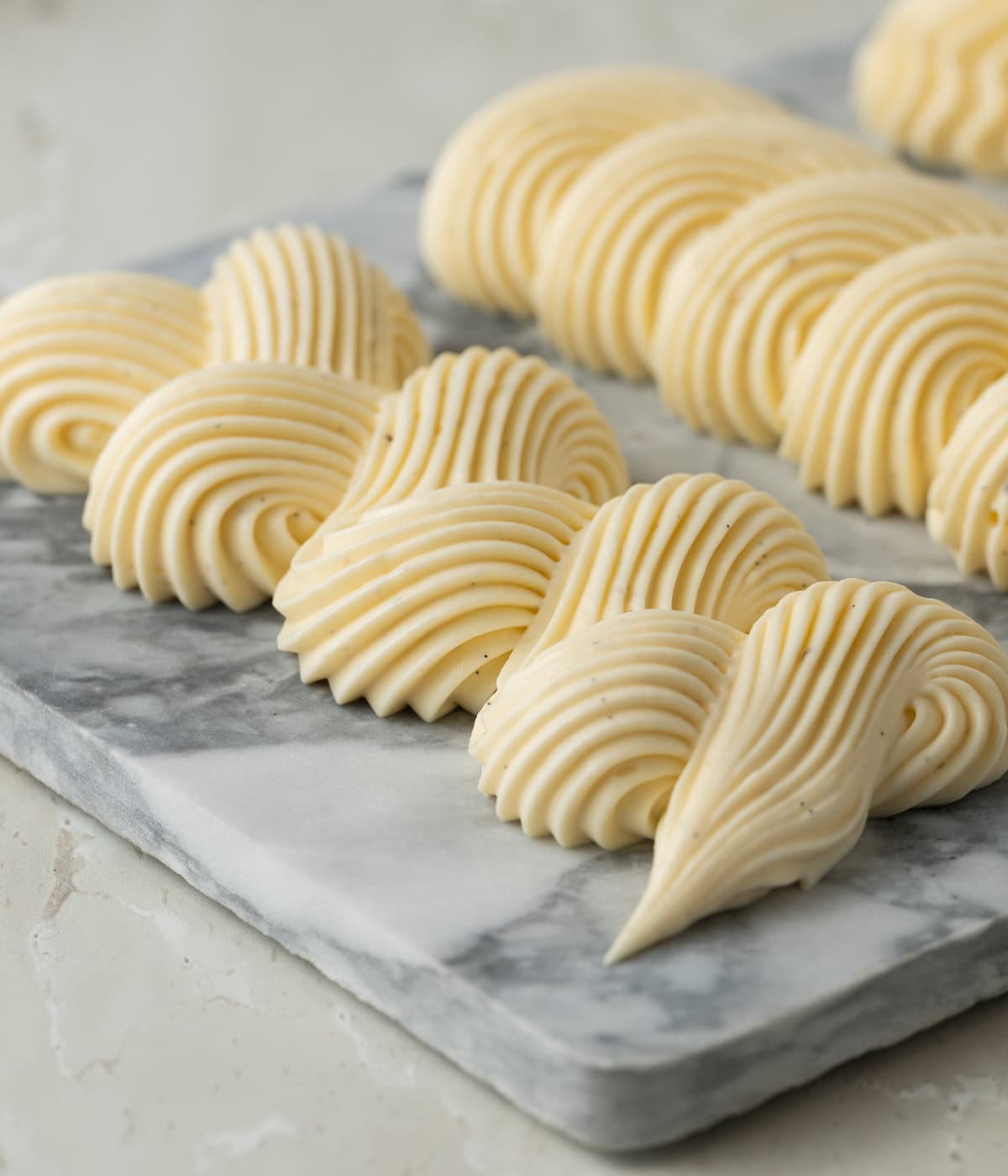
Tips & Troubleshooting
The cream is lumpy or grainy: usually indicates that the crème pâtissière was cooked past its optimal temperature (82 to 84 degrees Celsius) and the egg yolks started to coagulate (scramble). Make sure to cook it slowly on low heat and use a kitchen thermometer to stop as soon as you’ve reached the right temperature. Continuously whisk while on the stove so that the mixture does not stick to the bottom of the pan.
The pastry cream is not setting: this can happen if the pastry cream was undercooked. Cornstarch only starts to gelatinise (thus stabilise and set the cream) around 60 to 70 degrees Celsius. If you stop cooking the cream too early, the starch will not be able to set it. It could also simply happen if the custard has not been chilled for long enough.
I over-whipped the whipped cream: try pouring a little bit of cold (un-whipped) cream into your whipped cream and mix very gently. If only very slightly grainy, go ahead and fold the cream into the custard. If it has started to split (the fat and water are separating), it might be too late to save it unfortunately.
How to use Crème Légère
- As a filling for tarts like my Strawberry Custard Tart or Mini Fruit Tarts.
- Inside choux pastry like Choux à la Crème, Choux au Craquelin (crispy cream puffs) or Éclairs.
- To make pastries such as Mille-Feuille.
- As a filling for layered cakes or Entremets.
Storing & Freezing
Crème légère will last for up to 3 days in the fridge. It should be stored in an airtight container or bowl, covered with plastic wrap touching its surface to avoid oxidising (a thin crusty layer will form at the top).
I do not recommend freezing light cream.
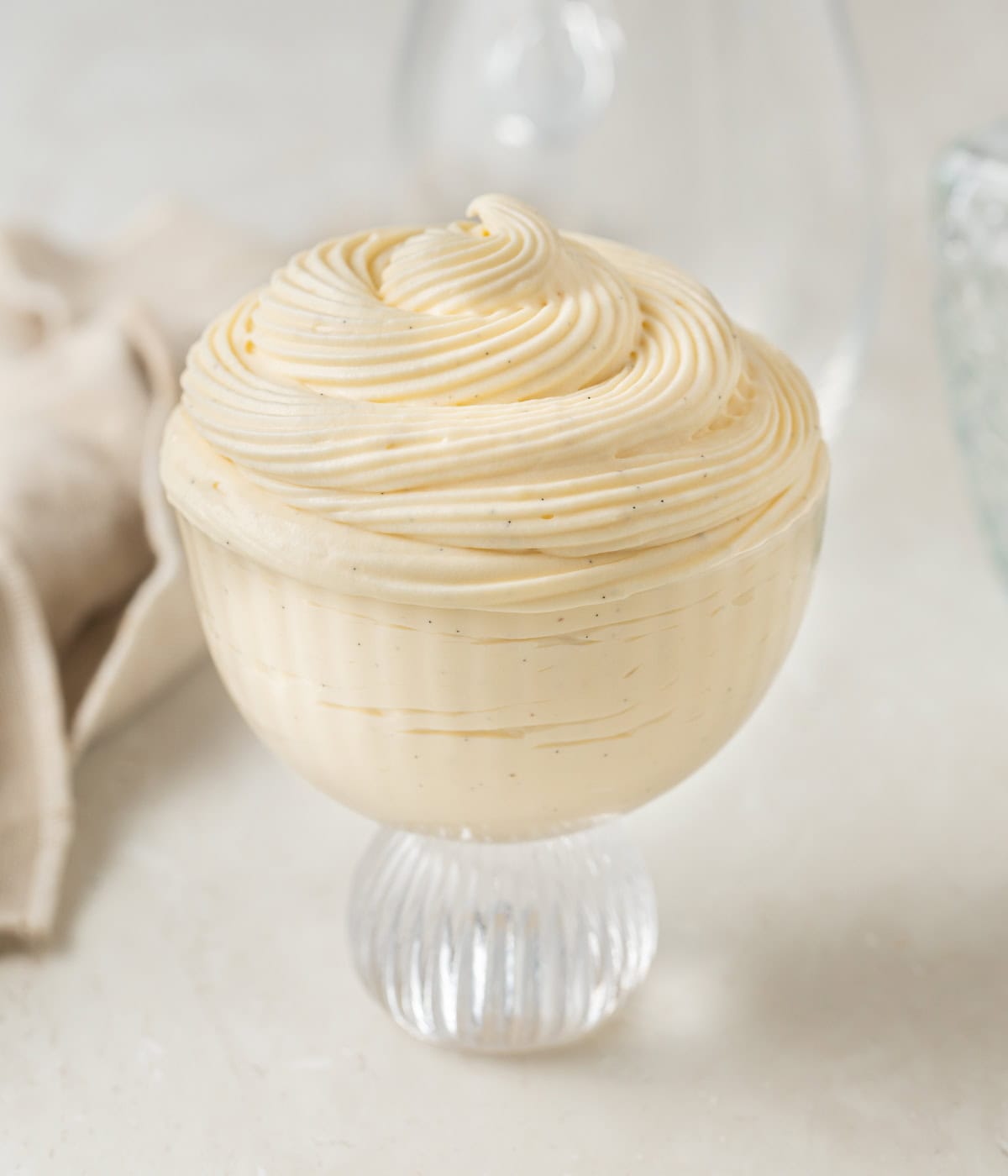
More French Creams
I am so excited to share that my debut cookbook
“Bite-Sized French Pastries for the Beginner Baker”
is now available for purchase!
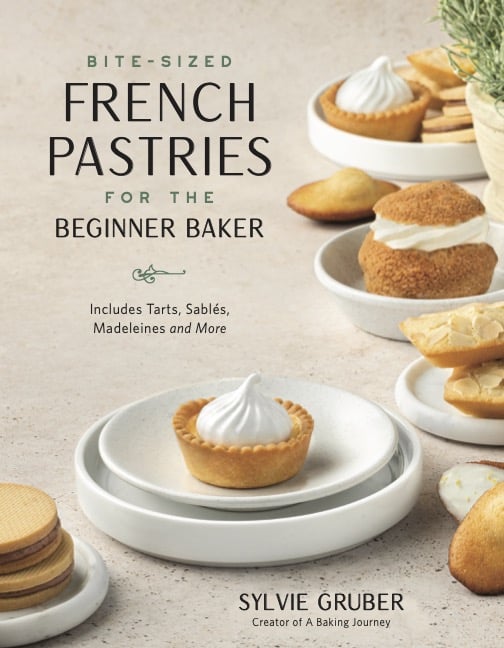
Recipe

Crème Légère (Light Pastry Cream)
Ingredients
- 500 ml Full Cream / Whole Milk
- 1 Vanilla Bean Pod or 2 teaspoon vanilla paste
- 4 large Egg Yolks at room temperature
- 60 gr Caster Sugar
- 40 gr Cornstarch
- 250 ml Thickened / Heavy Cream 35% fat content
Instructions
-
Place the Milk in a medium-size saucepan. If using a vanilla bean, slice it in half lengthwise, scrape the beans inside the vanilla pod and add them to the milk along with the remaining pod.
-
Turn on medium low heat and bring to a simmer. Once it starts to simmer, turn off the heat, cover with a lid and leave to infuse for at least 20 minutes. If using vanilla paste or extract, you do not need to infuse the milk first.
-
In the meantime, whisk the egg yolks and sugar in a large heatproof bowl until smooth. Add the cornstarch and whisk until no lumps remain. You should get a thick mixture.
-
Slowly pour the warm milk (see note 1) over the egg mixture while you continuously stir to “temper” the eggs (see note 2). Whisk well until fully combined then pour the whole mixture back into the saucepan.
-
Place the saucepan over low heat and cook for about 5 minutes or until the custard has thickened and reached 82℃ / 180℉. Make sure the cream does not start boiling and to continuously whisk while the cream is cooking so that it does not stick to the bottom of the pan.
-
Transfer into a large clean bowl or shallow pan (to cool it down more quickly). Cover with plastic wrap touching the surface of the cream. Refrigerate for at least 2 to 3 hours, preferably overnight.
-
Pour the cold heavy cream in a large bowl (if using a hand mixer) or the bowl of your stand mixer fitted with the whisk attachment. Start whipping the cream on medium speed, slowly increasing to medium-high spread until you reach stiff peaks (see note 3).
-
Take the chilled pastry cream out of the fridge. If chilled in a shallow pan, transfer into a large bowl. Using a whisk, beat it lightly to loosen it.
-
Add about 1/4 of the whipped cream to the pastry cream and gently whisk until fully incorporated. Switch to a spatula and add the remaining whipped cream in two or three times, gently folding it into the custard until it has been completely incorporated and you get a light, fluffy mixture.
-
If not using straight away, keep stored in the fridge (with plastic wrap touching the surface of the cream) until ready to use. It will last for up to 3 days.
Video
Notes
- If you have been infusing the milk with vanilla, remove the pod and bring back to a simmer before adding to the egg mixture.
- “Tempering” is a way to slowly and gently increase the temperature of the egg yolks. This allows to avoid a temperature shock that could make the eggs scramble.
- I recommend slowly down after reaching medium peaks so you can insure you keep whipping the cream without going over stiff peaks, where the cream would start turning grainy.
Nutrition
Made this recipe?
Let us know if you liked it by leaving a comment below, and tag us on Instagram @a.baking.journey with a photo of your creation!
The post Crème Légère (Light Pastry Cream) appeared first on A Baking Journey.